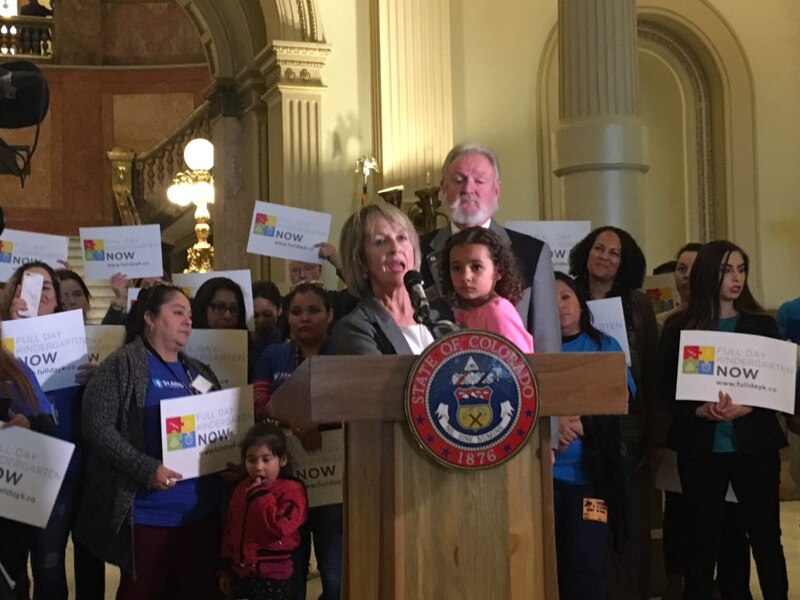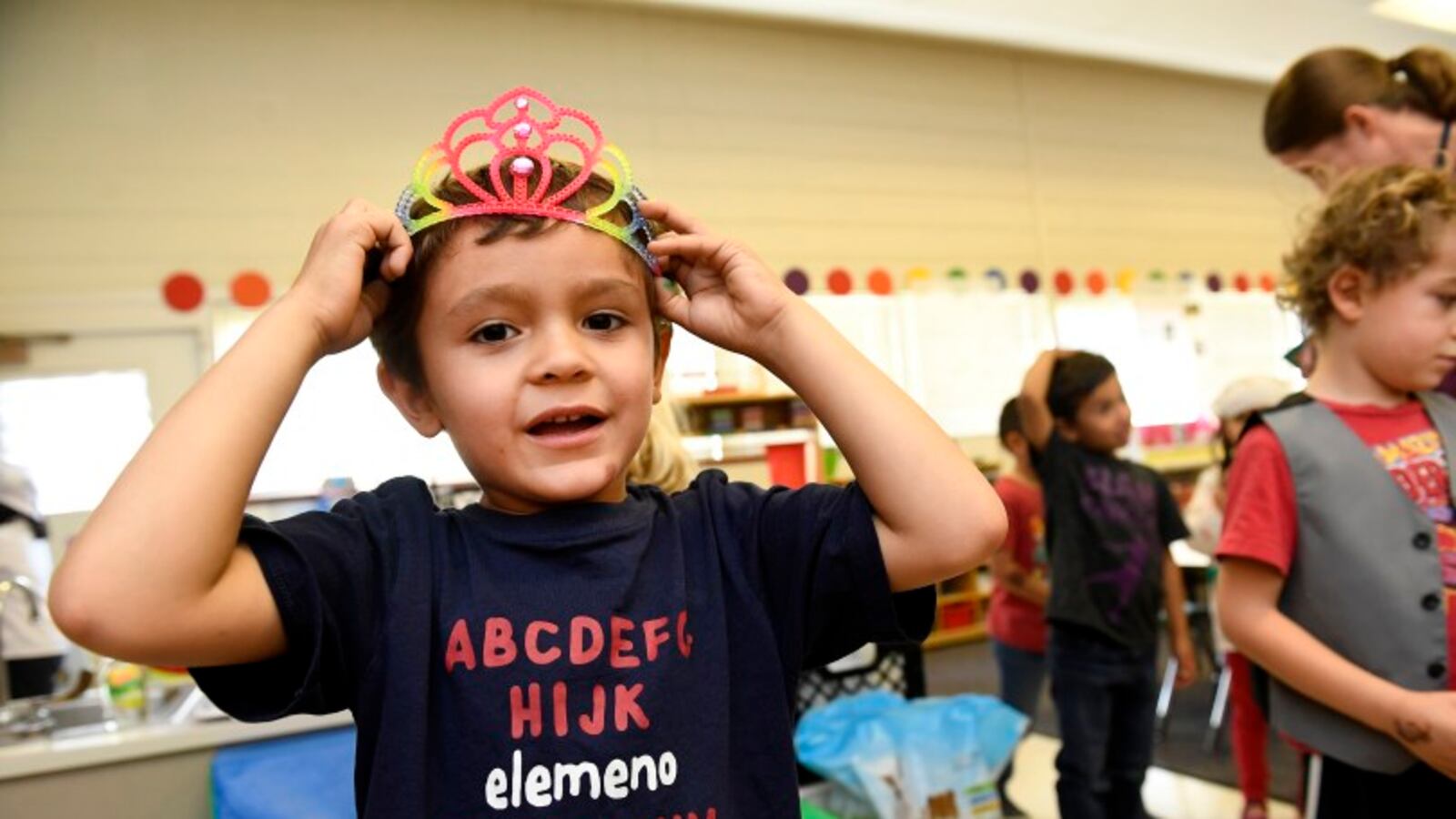Large Colorado school districts that collectively serve thousands of children in half-day kindergarten programs are preparing to switch to full-day programs this fall, potentially pushing up the cost of Gov. Jared Polis’ signature education initiative.
Lawmakers have set aside $185 million — about 80 percent of what Polis requested — to pay for full-day kindergarten next year. Their logic in not paying for all of it: That not all districts will immediately make the jump and that not all parents will enroll their children in full-day since there is no mandate.
But a number of districts — including Boulder Valley, Cherry Creek, and Douglas County in the Denver metro area, and Grand Junction-based District 51 — are pushing to make the jump next fall, concerned about the academic and financial ramifications if they don’t.
“With free full-day kindergarten across the state, nobody wants to lose enrollment,” said Ted Knight, assistant superintendent for the Douglas County School District, where 1,600 students, a little more than a third of all kindergartners, are in half-day programs this year.
Some lawmakers were already concerned about the long-term sustainability of Polis’ plan, which depends on local property tax revenue remaining high. The eagerness of districts to move to full-day kindergarten speaks to the importance of ensuring a good start for young learners even as it raises questions about Colorado’s ability to pay for it.
As lawmakers begin the hard work of shepherding the kindergarten funding bill through the approval process, advocates insist the state can afford it — and must. They cite a long list of benefits, including stronger reading skills, better identification of learning disabilities, the hundreds of dollars a month it will put back in the pockets of parents paying tuition, and the millions of dollars a year it will free up for school districts that cover what the state won’t.
Colorado currently funds kindergarten students at a little more than half the rate of older students. Statewide, nearly 50,000 students attend full-day programs, while another 13,300 are in half-day. Some districts pay for kindergarten out of their own funds, and many families pay tuition for full-day programs. Bipartisan legislation would fund kindergarten students at the same rate and ban districts from charging tuition. The first hearing takes place this week in the House Education Committee, and there is significant political momentum behind it.
“The kindergarten train is coming,” state Rep. Jim Wilson, a Salida Republican and longtime champion of funding kindergarten, recently told supporters. “You can get on board, you can jump out of the way, or you can get run over, cause it’s coming.”
Crystal Jennings, a mother of three from Colorado Springs, recently visited the Capitol to urge lawmakers to approve funding. Traveling around the country as part of a military family, she paid for private full-day kindergarten for one child, had another in a half-day program, and then was able to enroll the third in full-day public kindergarten.
She didn’t feel like her son in half-day got the same experience.
“There’s logistical and financial challenges,” she said. “But what’s most important to families is: Are children learning?”
Ana Arteaga, the mother of a Denver high school student and a 3-year-old, said paying for kindergarten would be a financial sacrifice. But she doesn’t see full-day kindergarten as optional, particularly because she knows students of color face hurdles their white peers do not.
“If the children are not educated at an early age, that is just extending this gap that we already have and we’re going to end up paying for it in the long run,” she said.
Scott Cooper, assistant superintendent in District 51 in Mesa County, said the academic expectations for kindergarten are much higher than they were a generation ago, and only full-day programs allow time for social and emotional learning alongside the fundamentals of reading and math.
“All the things we used to do in kindergarten that we don’t do anymore? We can bring those back when we have a full-day curriculum: sharing, taking care of your friends, kindness,” said Cooper, who started his career as a kindergarten teacher 18 years ago.
Related: Full day kindergarten across the nation: Where does Colorado fit in?
District 51’s board decided last year to make full-day kindergarten a priority, regardless of whether the state funded it. About half the district’s 25 elementary schools offer full-day using federal funds, while the other half offer a combination of full- and half-day programs. About 900 students, or two-thirds of Mesa County kindergartners, attend half-day programs this year.
Cooper’s been preparing for the building renovations, curriculum changes, and hiring that will be necessary to offer full-day kindergarten to all District 51’s students at no charge. If the state doesn’t fund it, the district plans to use a combination of preschool money, literacy grants, and other money to cover the cost, though it will be a stretch.
But state funding would free up all that money and more, allowing the district to offer 360 preschool slots to low-income parents and provide more robust math and literacy support to struggling students through third grade.
“It’s going to be much, much more of a benefit than just the kindergarten grade,” Cooper said. “We’re talking about pre-K through third grade being enhanced.”
These types of indirect benefits are part of Polis’ pitch for full-day kindergarten. An estimated 30,000 families won’t have to pay tuition of between $300 and $400 a month. More than 5,000 state-funded preschool slots that districts were using to cover the second half of the kindergarten day will be available for their original purpose. Federal funds for high-poverty schools can go to other services, and state literacy grants can be used for more targeted reading instruction.
In Greeley, which covers the cost of full-day kindergarten, and in Denver, which subsidizes tuition for low-income families, money freed up by state funding will go toward teacher pay raises.

Unlike most of its neighboring districts, the relatively affluent Cherry Creek district covering Denver’s southeast suburbs hasn’t used other means to offer full-day kindergarten at most of its schools, though many parents pay for enrichment programs that occupy their children the rest of the school day. When Cherry Creek introduced full-day programs a decade ago at its highest-poverty schools using federal money, not only did all the students previously in half-day programs enroll, there was a 20 percent bump as private school parents switched over.
“Kids came flooding out of the private kindergartens,” said Tony Poole, a Cherry Creek assistant superintendent. “It’s not a giant leap. If I can put my kids in a public school system for a full day for free with a certified teacher, why wouldn’t I?”
He expects the same kind of adoption rate when the district rolls out full-day programs at the rest of its elementary schools, which it hopes to do this fall. The biggest challenge is space. Expanding kindergarten requires moving some preschool classrooms, including to new standalone preschool sites, ordering furniture and curriculum, and hiring roughly 60 new teachers. It’s a lot to do in a few short months.
“I think it will be exceedingly popular,” Poole said. “It’s good for families, and it will be great for kids.”
More than half the Colorado students in half-day programs attend school in districts planning to move to full-day this fall, with Cherry Creek alone representing 3,100 half-day students.
At a recent meeting with parent advocates, Polis downplayed any concern about the impact of a mid-year budget adjustment to accommodate additional kindergarten students. For the last two years, overall student enrollment has been less than predicted, freeing up additional education money in the state budget. Even in districts that switch to full-day, some parents may choose to stick with half-day. In states where attendance is not mandatory, enrollment is often less than 90 percent. Polis said those trends mean the system almost certainly has the flexibility to cover additional kindergarten enrollment.
The most recent budget forecast indicates the state economy might be slowing. The last effort to fund full-day kindergarten was scuttled by the Great Recession. The kindergarten legislation includes a provision that districts could start charging again if the state ever reduces funding for those students.
Some Dougco elementary schools may be too crowded to offer full-day kindergarten for all students next school year, but Knight said Dougco is committed to making sure any parent who wants full-day kindergarten can find it nearby, even if it’s not in their neighborhood school.
Meanwhile, in Boulder Valley, administrators used their most recent bond program to do renovations at every elementary school to be ready should the state ever fully fund kindergarten.
“We’re so excited,” said Robbyn Fernandez, an assistant superintendent. “We feel so fortunate to be poised for this.”
About one-third of the district’s students already attend full-day programs at Title 1 schools, which serve large numbers of students living in poverty. Like Cherry Creek, Boulder Valley has neither subsidized kindergarten for the remaining 1,200 students nor has asked parents to pay tuition, even on a sliding scale as Denver does. District officials didn’t want to create an “equity issue” between those who could afford it and those who could not, so it stuck with half-day programming for most students.
Fernandez said half-day kindergarten teachers are used to “sprinting” through two hours and 45 minutes a day to cram in all the academic subjects that kindergarten is now expected to cover, so Boulder Valley plans to train them in new teaching techniques. That’s not how young students learn best, Fernandez said, and full-day instruction will allow a slower pace and intentional play that reinforces the material that students covered that day. Among the supplies teachers will need: play centers, blocks, stuffed animals, plastic food, and toy kitchens.
“In general, philosophically, we believe that full-day kindergarten for every student is the best scenario, because it is about maximizing every student’s potential, and that starts with the best early instruction,” Fernandez said. “When we don’t have universal full-day kindergarten, we are always leaving some students behind.”


